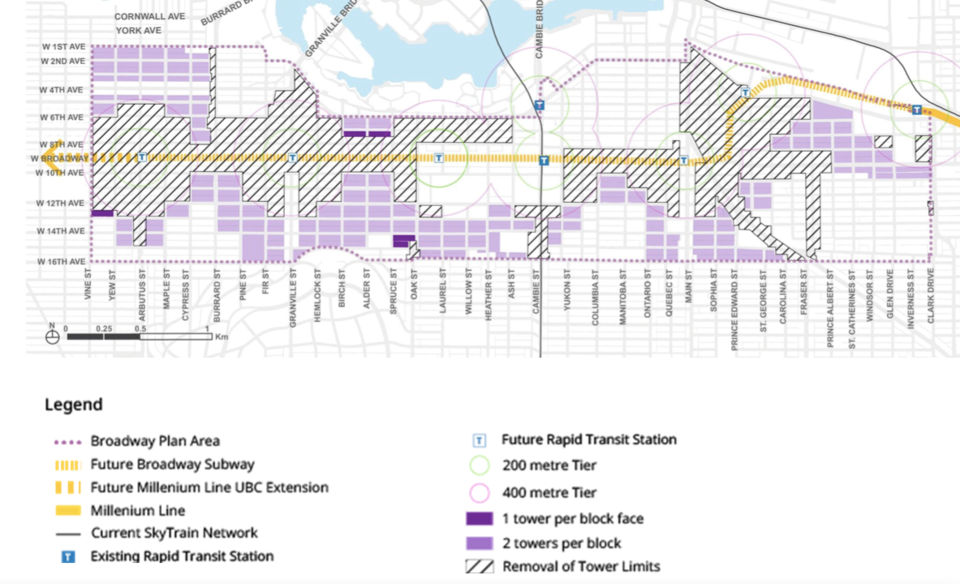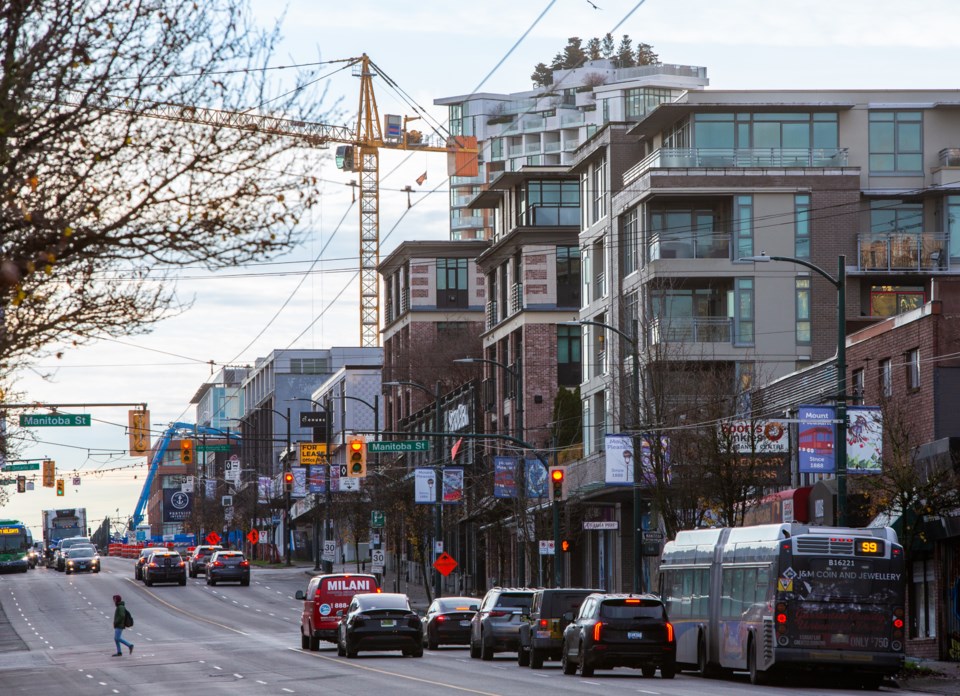A series of proposed amendments to the Broadway Plan including removing existing tower limit policies to allow more and taller highrises in certain areas of the Broadway corridor will be up for debate at city hall Wednesday.
The plan was approved by the previous council in June 2022 and came into effect Sept. 1, 2022. The plan covers a 500-block area from Vine Street to Clark Drive, along 16th Avenue and is bordered roughly by False Creek and adjacent neighbourhoods.
The report going before council provides an update on the scale of development and recommended changes to adjust the plan, which is largely being driven by provincial legislation regarding the call for high-density development around transit hubs.
Council’s recent changes to public view cones and push for the construction of more hotels are other reasons cited in the rationale for the amendments.
The proposed change attracting the most attention is staff’s recommendation to remove tower limit policies in areas closest to transit, shops, services and amenities, generally within 400 metres of SkyTrain stations.
Currently, the plan limits the number of towers allowed on a block or block face in several locations of the plan area; in most cases, it’s one or two. That policy was put in place to “help maintain solar access and livability and to create more variation in building heights and types,” according to the first draft of the plan.

'Exceed the minimum heights'
A map included in staff’s report shows the areas where the limits on towers should be scrapped — and those areas are consistent with transit stations that will serve riders when the Broadway Subway opens sometime in late 2027.
“The amendments to areas within defined [transit-oriented areas] propose to increase the permitted building heights and densities to align with and, in some cases, exceed the minimum heights and densities prescribed by the province,” the staff report said.
“It is important to note that the achievable building heights and densities on any given site will be contingent on other policy requirements, including minimum site frontage, tower separation, protected public views and allowable uses.”
'20 storeys or greater'
Amendments to allow taller buildings outside of transit hubs are also being recommended.
The staff report said the intent of “allowing flexibility in building height” is to accommodate a greater range of building forms, create on-site public open space on the site of a new development and achieve maximum density on larger sites.
“Maximum building heights would vary depending on the existing allowable building height for the area,” the report said. “Generally, existing allowable heights are 20 storeys or greater in areas where height flexibility would apply, and additional building height would not exceed six storeys.”
Policies that protect solar access on “key public spaces” — keep a building or area from under constant shadows — or maintain protected public views would be maintained, the report said.
“Most tower projects are on standard lot sizes and will not require additional height; however, staff expect there to be occasional projects on larger lots where flexibility in building height would help to achieve better urban design outcomes,” the report said.

'Frenzy of profit speculation'
The proposed changes before council have riled up a group of planners, architects and academics, some of whom are retired but well respected for their work and experience in urban planning.
In an open letter to Vancouver council, 22 people including the city’s former co-chief planner Larry Beasley requested the politicians pause the plan and consult more widely with the public and experts.
Their concerns vary:
• “The Broadway Plan promised a measured buildout over 30 years, but we are seeing a frenzy of profit speculation, land banking, flipping and land inflation into the heart of vulnerable established, mixed-use neighbourhoods due to the plan which — by the city’s own estimates — will demolish thousands of existing, affordable homes, resulting in forced resettlement to thousands of people in pursuit of what may be little if any net increase in affordable housing.”
• “In a 30-year buildout, existing good, affordable housing should be protected, not demolished. Renewal of aging housing can happen later in the plan when replacement housing is there for impacted tenants to transfer directly to.”
• “The destabilizing impact of evictions extends far beyond the people who are directly impacted as many in similar buildings live in fear of the same outcome. ‘When am I next?’ This is causing considerable emotional distress for thousands.”
'Subject to eviction'
• “The ‘enhanced tenant protections’ are helpful, but do not consider the many issues being experienced by tenants who are subject to eviction. The disruption and anxiety for many vulnerable renters is considerable and the protections do not adequately compensate or address meaningful failures in the tenant protections.”
• “Under the plan, many tenants are not being offered anything like equivalent replacement units when they do eventually return at some point in the future. The best ‘tenant protections’ is not to evict tenants!”
• “The experience of years of good planning practices, which Vancouver has been lauded for, are being ignored in favour of a reliance on one type of housing; small, expensive units in towers.”
• “Towers concentrated on Broadway and the immediate areas near transit make sense, but as we move blocks away from transit, we should encourage a range of housing which will suit families; low-rise apartments, row houses, townhouses and infill which is sympathetic to neighbourhoods and organically enhances the community and social fabric so highly valued, instead of in conflict with it by dropping towers in the middle of RT and RM zones.”
• “Staff insist that the public consultation was robust, but much of the consultation took place at the onset of the pandemic and the vast majority are only now appreciating the extent and scope of this detailed plan. Residents understood the broad concept of a revitalized Broadway and towers adjacent to transit nodes, but are shocked to learn of evictions, demolition and towers on residential streets many blocks away from the actual transit area. A meaningful public consultation about how the plan is going so far and where it will go next is vital.”
Other signatories to the petition include Scot Hein, former senior urban designer/development planner for the City of Vancouver; Tom Phipps, retired senior planner at the City of Vancouver; Penny Gurstein, former director at UBC’s School of Community and Regional Planning; and Christina DeMarco, former lead planner for the Metro Vancouver Regional Growth Strategy.
139 projects
As of Oct 1, there are 139 projects within the Broadway Plan area that are in the development pipeline. That includes 44 rezoning inquiries, 66 rezoning applications and 29 approved rezonings.
Of those projects,109 are residential or mixed-use residential projects, comprising a total of 20,324 residential units, which includes 15,372 market-rental housing units, 3,549 affordable units (below-market rental and social housing) and 1,403 homeownership units (strata).
A total of 139 people had registered to speak to council on Wednesday.





